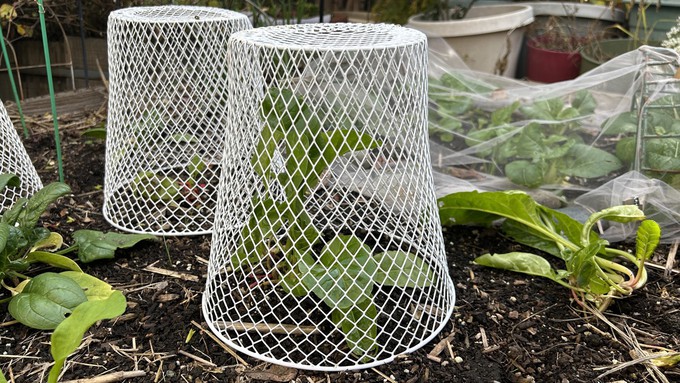
Easily found and budget-friendly items for gardeners

These wire wastebaskets can protect young plants, while tulle fabric, in background, can be used as floating row cover for brassicas in a small garden. Kathy Morrison
Still shopping? Or still being asked for gift ideas for yourself? Here are my five favorite gardening hacks that use inexpensive items not generally thought of for gardening:
– Wire wastebaskets, found at just about any dollar store. A fellow gardener, of course, tipped me off to the usefulness of these baskets in protecting small transplants from squirrels, birds or roving pets. They come in a couple of sizes, but I like the taller ones. (Use garden staples to hold them down if necessary.) I have them over my smaller chard and spinach plants right now, see the photo above.
– Several yards of tulle, available at fabric stores. This pen-weave polyester fabric is often used in ballet costumes and wedding veils, but I’ve found it incredibly useful in the garden. (I bought 10 yards this past spring.) It’s much cheaper than bird netting, and much safer for the birds. I use it on berry bushes and as a small floating row cover over the bok choy in my raised bed. (In background of photo.) You can sew it together to make a large cover if needed. It’s reusable and washable. And it comes in many colors, which adds some whimsy to the vegetable garden.
– Wooden spring clothespins, available at most hardware stores. These come 36 to a package, and they’re invaluable for anchoring shade cloth on tomato cages. But I also use them to clip tags on pots, affix tulle around berry plants and temporarily close seed or fertilizer packages. The wooden ones last much longer than the plastic ones.
– Painters tape, sold at hardware and other stores. I go through a roll of this every year, using a Sharpie on the tape to mark sixpacks of tomato starts, then the seedlings when they’re repotted. The taped tags don’t flip out of the sixpacks or pots like classic plant tags can, and can’t get accidentally mixed up. The tape also can close seed packages without destroying the paper or the info on them. Tip: Get a good brand, whether 1-1/2 inches or wider, green or blue, because the cheap stuff will quickly drive you crazy.
– Cup hooks, especially the kind with the closing clip, at hardware and home goods stores. Screw one into a wooden post or fence to help anchor a leaning plant with stretch tape, or use more hooks to hold a string trellis for flowers or shade cloth for new plantings.
Looking for more gift ideas? Here's a post with suggestions I wrote last year.
Comments
0 comments have been posted.Sacramento Digs Gardening to your inbox.
Sites We Like
Garden Checklist for week of May 12
Get your gardening chores and irrigation done early in the day before temperatures rise.
* Plant, plant, plant! It’s prime planting season in the Sacramento area. Time to set out those tomato transplants along with peppers and eggplants. Pinch off any flowers on new transplants to make them concentrate on establishing roots instead of setting premature fruit.
* Direct-seed melons, cucumbers, summer squash, corn, radishes, pumpkins and annual herbs such as basil.
* Harvest cabbage, lettuce, peas and green onions. This heat will cause leafy greens and onions to flower; pick them before they bolt.
* In the flower garden, direct-seed sunflowers, cosmos, salvia, zinnias, marigolds, celosia and asters.
* Plant dahlia tubers. Other perennials to set out include verbena, coreopsis, coneflower and astilbe.
* Transplant petunias, marigolds and perennial flowers such as astilbe, columbine, coneflowers, coreopsis, dahlias, rudbeckia and verbena.
* Keep an eye out for slugs, snails, earwigs and aphids that want to dine on tender new growth.
* Feed summer bloomers with a balanced fertilizer.
* For continued bloom, cut off spent flowers on roses as well as other flowering plants.
* Got fruit trees? If you haven't already done so, thin orchard fruit such as apples, peaches, pears, pluots and plums before they grow too heavy, breaking branches or even splitting the tree. Leave the largest fruit on the branch, culling the smaller ones, and allow for 5 to 6 inches (or a hand's worth) between each fruit.
* Thin grape bunches, again leaving about 6 inches between them. For the remaining bunches, prune off the "tail" end, about the bottom third of the bunch, so that the plant's energy is concentrated in the fruit closest to the branch.
* As spring-flowering shrubs finish blooming, give them a little pruning to shape them, removing old and dead wood. Lightly trim azaleas, fuchsias and marguerites for bushier plants.
* Add mulch to the garden to help keep that precious water from evaporating. Mulch also cuts down on weeds. But don’t let it mound around the stems or trunks of trees or shrubs. Leave about a 6-inch to 1-foot circle to avoid crown rot or other problems.